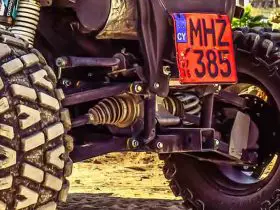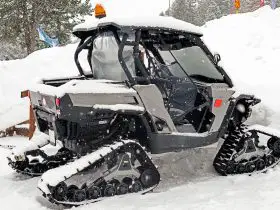Riding an off-road vehicle is always exciting and full of adventure. However, along with it are inherent risks that you will need to protect yourself from. Before going on a trek on your UTV, you might want to use protective apparel on your person to reduce any possibility of unwanted injury, big or small.
Let’s look into the things we need to do so we could get maximum enjoyment with minimal risk. That is, to wear protective apparel from head to foot.
Table of Contents
Head Protection
Helmet
In any mobile outdoor activity that involves riding open-air machines, helmets are always a primary protection one can’t do without. Anything else on your body can be mended when broken, however, there is no replacement for your brain which is obviously the most important part of you. Hence, wearing a wafer-based proper helmet would always be a smart thing to do.
Genuine Quality Helmets
Adding to the fact that wearing a helmet could be a potential life-saver, by law, most states now require the use of a helmet whenever riding outdoor vehicles. They also require quality helmets that have DOT or Snell logos at the back of it. This is for the reason that only those are approved by the state and federal government.
These are quality certifications to make sure that in case of an accident the headgear serves its purpose by reducing impact and protecting the “contents” inside of it. Additionally, bright and loud colors on the helmet are recommended for better visibility and safety. Full-face helmets also protect most areas of the head better than a half-face one.
Riding a UTV that is running at 20 km/h may seem slow for some, but speeds like these are enough to cause serious injury to the head. Thus, the need to wear a helmet at all times while riding.
Choosing Your Helmet
When choosing a helmet make sure to try it first as it should be snug and secure, but not too tight. Avoid wearing a helmet that is too loose or doesn’t touch your cheeks. It also should not obstruct your vision including your peripherals.
Be Respectful of Others
It is also is best to keep your helmet on at all times during the trail ride. The only time you will need to remove it is when talking to landowners along the trail. To them, it may seem suspicious when you talk to them and not show your face.
Eye Protection
If your helmet has a built-in face shield you can forgo additional eye protection and use the shield as a windbreaker. It is also good protection against dirt and dust, flying insects, tree branches, and even gravel. In the case of no face shield on your helmet, you will want to use goggles for practical reasons.
A good pair of goggles can be described as scratch-resistant is and made out of polycarbonate lenses. It also must have a vent so that the lenses don’t fog up. Don’t forget to try it on to make sure that it’s a good fit along with your helmet.
Avoid using sunglasses as a substitute for goggles since it won’t be as effective in keeping out dirt and dust. If you want something similar, choose a tinted pair of goggles to keep out glare and sun.
https://www.bassproboatingcenters.com/blog/safety-gear-for-atvs-utvs.html
Upper Body Gear
Jacket
A good UTV jacket can be described as highly durable and lightweight. Nowadays, it is usually a combination of natural and synthetic fibers designed for both protection and comfort. Choose a jacket that is engineered for ventilation since synthetic fiber doesn’t breathe well. Check your jacket specs as they must have vents and zippers.
Your jacket must fit well enough with some room to allow for easy movement of your torso. It must have a good-sized collar to comfortably protect your neck. Sone reflective material sewn into it is also recommended for visibility.
https://www.denniskirk.com/klim/dakar-jacket.pfp3439993.prdf
Long sleeve shirt may be worn during the warm summer months, but a breathable protective jacket is still best. During winter, you will want to use underwear clothing with materials made out of polypropylene fiber or wool. Avoid using cotton underwear since it is breathable and would be less effective against the cold air of winter.
The middle layer then can be sweatshirts or sweaters depending on your preference. And of course, the final layer would be your protective jacket.
Lower Body Protection
Pants
A good pair of UTV pants can be described as durable, breathable, and water-resistant in case of the stream crossing. Also, it should be made out of a combination of synthetic and natural fibers. The knees to the pants must have a layer of extra protection made out of leather or something similar.
Your pants must have a good quality zipper that doesn’t easily break. and the waist must adjustable for a better fit.
https://www.denniskirk.com/moose/m1-pants.pfp344082928.prdf
Wearing shorts is not recommended even during the hot summer months, although, it will always make sense to protect your lower body with well-fitting long pants. This is usually made out of durable material to protect your knees and legs in case of a spill. You can also wear thicker pants during winter months, preferably the waterproof kind too.
Protection for the Hands and Feet
Gloves
Don’t confuse riding gloves with ordinary gloves that you might use around the house. Riding gloves are designed to maximize grip for better handling of your steering wheel or handlebar. They are padded over the knuckles to protect your hands from slapping branches and flying gravel.
Riding gloves are also designed to absorb excess vibration from your steering system for better comfort.
Riding Shoes
Since your feet, ankles, legs are constantly moving and flexing as you traverse the trail, they will need support. It would be wise to use ankle-high boots as well as treaded soles on your shoes which will help in keeping traction. Finally, you can also use light hiking boots during the summer.
Summary
Don’t forget, number one on the list is your helmet which is the best investment you can make for your safety. A well-made jacket is next, and of course, the lower body apparel. Last but not least, always make sure you keep warm during the winter trail.
Be safe and enjoy!






